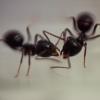





Edited by chatogaster, September 8 2017 - 7:53 AM.







Edited by chatogaster, September 8 2017 - 7:53 AM.
We should respect all forms of consciousness. The body is just a vessel, a mere hull.
Welcome to Lazy Tube - My Camponotus Journal
I'm not sure what are you trying to say ![]() Are you suggesting they have hibernated? Are you suggesting I should hibernate them?
Are you suggesting they have hibernated? Are you suggesting I should hibernate them?
I'm aware of the phenomenon, that's why I mentioned it in the post. What, I think, speaks against the explanation that they hibernated is:
- The larvae stopped growing in the very middle of the summer, both calendar- and temperature-wise.
- They have access to water and temperatures aren't too high, so it shouldn't be aestivation either.
- Other queens of the same species from the same area had their larvae grow normally.
- The queen is active and is grooming the larvae.
Edited by chatogaster, September 8 2017 - 9:21 AM.
Camponotus larvae take a very long time to develop and pupate, because of this it is not uncommon for these ants to go into hibernation early. Having workers that just emerge before hibernation and then die over the winter due to lack of reserves is not a good strategy.
I know several german Journals where Camponotus ligniperda colonies have gone into hibernation preparation (little activity, no brood growth) up to four weeks ago.
So yes, your ants are preparing for hibernation - the fact that the larvae look sort of shrunken (not like fat filled balloons) supports this (they lower their amount of body water to make their glycerol anti-freeze work better). It doesn't mean you have to put them into the cold yet, but you shouldn't expect any more growth this year.
(I'd recommend to offer the queen some sugar water or honey before you send her into hibernation, she looks kinda slim, which may also be the reason she decided to wait instead of expending her scarce resources on brood development when winter is coming).
Edited by Serafine, September 8 2017 - 1:16 PM.
We should respect all forms of consciousness. The body is just a vessel, a mere hull.
Welcome to Lazy Tube - My Camponotus Journal
I see, that makes sense, thanks a lot!
I'm still surprised there is such a difference in behaviour between queens from the same species and area, but - as you say - maybe that's due to this specific queen having fewer reserves for some reason.
I'm feeding her Sunburst Nectar, will also try protein.
When would you recommend hibernating her? Denmark has a bit more moderate climate than Germany, with negative temperatures only between mid-December to mid-March.
Some time in November then? Or on some cue from the queen?
Proverbs 6:6-8 New International Version (NIV)
6 Go to the ant, you sluggard;
consider its ways and be wise!
7 It has no commander,
no overseer or ruler,
8 yet it stores its provisions in summer
and gathers its food at harvest.
0 members, 1 guests, 0 anonymous users